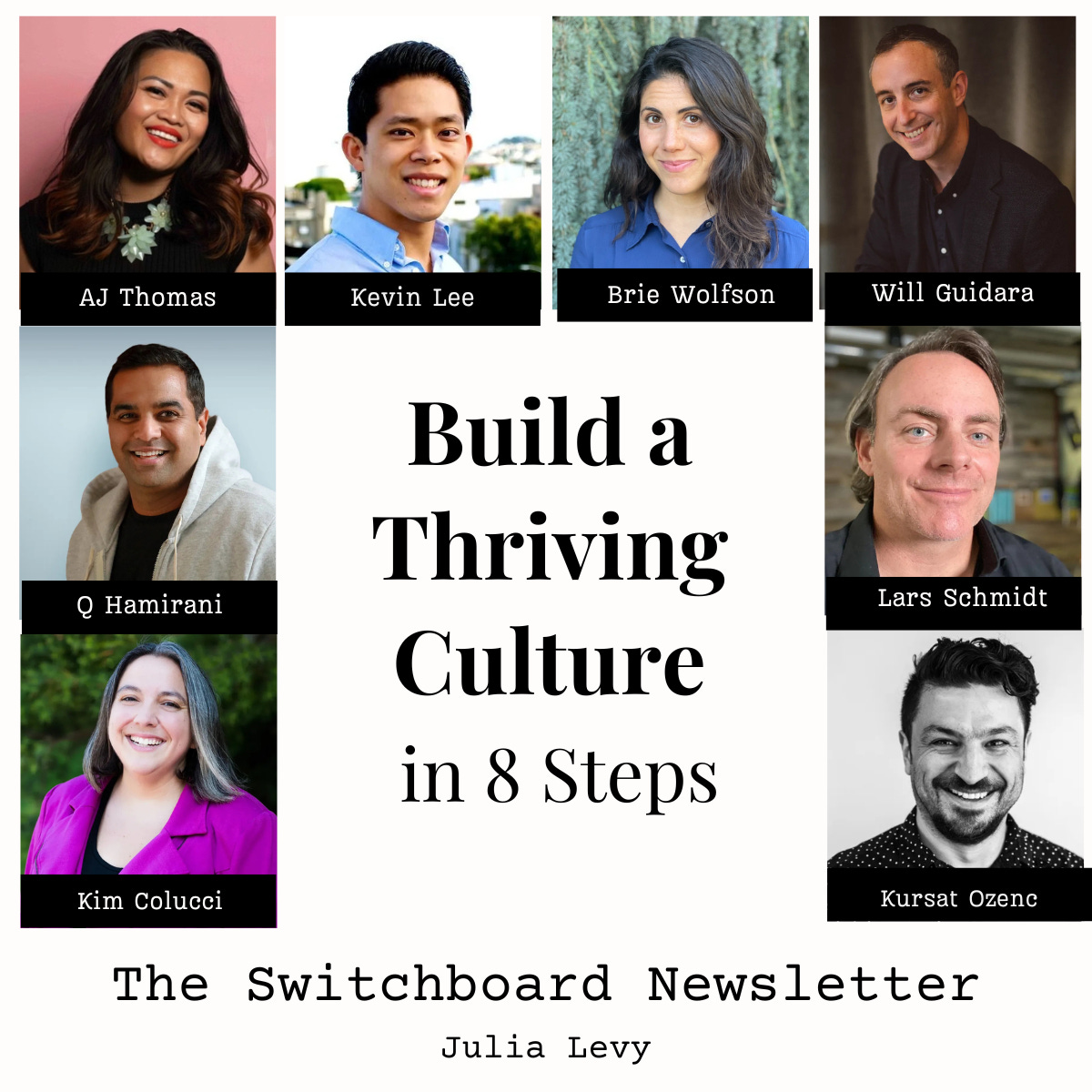🏗️ Build a Thriving Culture in 8 steps
Learn from Top Leaders: Authors, Professor, Founders and More
Hello. It’s Julia. Welcome to this edition of The Switchboard, my newsletter exploring the ways we communicate and connect at work and beyond.
If culture builders were architects who designed communities with blueprints, what would be the building blocks for the foundation? I compiled 8 best practices from my interviews with authors, professors, people leaders, founders and more to support anyone building community at work. Whether it’s your full-time role or a side-internal project passion, these steps offer a blueprint for building a thriving culture. Apply one, two or more of these recommendations:
🌭 Be Unreasonable: Will Guidara
🧃 Build Together: Brie Wolfson
📐 Design Culture Like a Product: Kursat Ozenc
🍜 Give Ownership: Kevin Lee
📸 Understand Your Community: Kim Colucci
🌝 Encourage Teamwork: AJ Thomas
💡Share Knowledge: Lars Schmidt
🏰 Build Trust: Q Hamirani
8 Steps to Success
🌭 Be Unreasonable: Will Guidara
Anyone who is successful is very intentional, relentless and creative in pursuit of whatever product they are building, unreasonable hospitality is about bringing that same relentlessness in pursuit of people – it’s not just the people you serve, but it starts with people you work with.
🧃 Build Together: Brie Wolfson
One of the highest-impact lessons I learned from working closely with Stripe’s then-COO Claire Hughes Johnson over the years was that the rollout counts for just as much (sometimes more!) than the content of the work. “And how are we going to bring people along,” she would always say. I learned over and over again that accounting for the perspective of my stakeholders in the rollout not only made it more likely that the work would catch on, but also made the content of the work itself better.
📐 Design Culture Like a Product: Kursat Ozenc
Culture can be designed like a product and culture interventions can take many forms, including artifacts, rituals, habits, and policies. Our perspective is heavily influenced by Ann Swindler, a renowned anthropologist who authored the seminal paper "Culture in Action." Our class prioritizes driving culture change through bottom-up efforts and human experience rather than relying solely on top-down changes.
🍜 Give Ownership: Kevin Lee
Employees are encouraged to host programs. Our senior food scientist hosted an event called Ramen 360 where everyone received a budget to go to a local ramen restaurant of their choosing. They had to document the entire experience end-to-end including what the interior design of the restaurant looked like, the cutlery and bowls and the different types of ramen that were on the menu. It was a fun experience to compare and share.
📸 Understand Your Community: Kim Colucci
Culture work is not just about understanding an organization but also the intricate tapestry of people that constitute it. Essential skills for thriving in this domain include empathy: This is at the heart of culture work. Truly understanding and valuing every team member's diverse experiences and perspectives ensures an inclusive and welcoming environment.
🌝 Encourage Teamwork: AJ Thomas
Teams transcend the general moniker of what we know, which is sports. Having a team spirit requires there is a sense of belonging to something and having a shared purpose with other people.
It’s about remembering that feeling you experienced when someone passed you the ball or when you had that encouraging word from a friend. You will never really be that self-made person without that team. A team is defined by these very four key things: giving and taking of curiosity, courage, connection and kindness.
💡Share Knowledge: Lars Schmidt
I knew that the more resources we could share the better — we were all experiencing this massive event at the same time and there was literally no playbook for it. I firmly believe that the more we can lean on each other, the greater we can help employers and employees.
🏰 Build Trust: Q Hamirani
I realized very quickly that if I were to succeed, it started with building trust and understanding what they were doing. Even as I was trying to implement operational efficiencies in their day-to-day lives like color coding the parts bins to help them easily identify when they were going to run out of them, I had to show them I was there to help. This experience helped me discover my passion for helping people, making the employees' and customers’ lives better.
Thank you to these leaders for your insights. Most of all, remember culture is specific to your organization. Only you can decide what’s best for your team. What are your building blocks? Good luck and keep me posted on how it goes.
What would you add to this list? I invite your thoughts below.
Thank you for tuning into this edition of The Switchboard. I’m always grateful for your support growing this community of caring communicators and connectors. If you enjoyed this article, consider sharing it with a friend or posting on LinkedIn. Signing off — Julia




